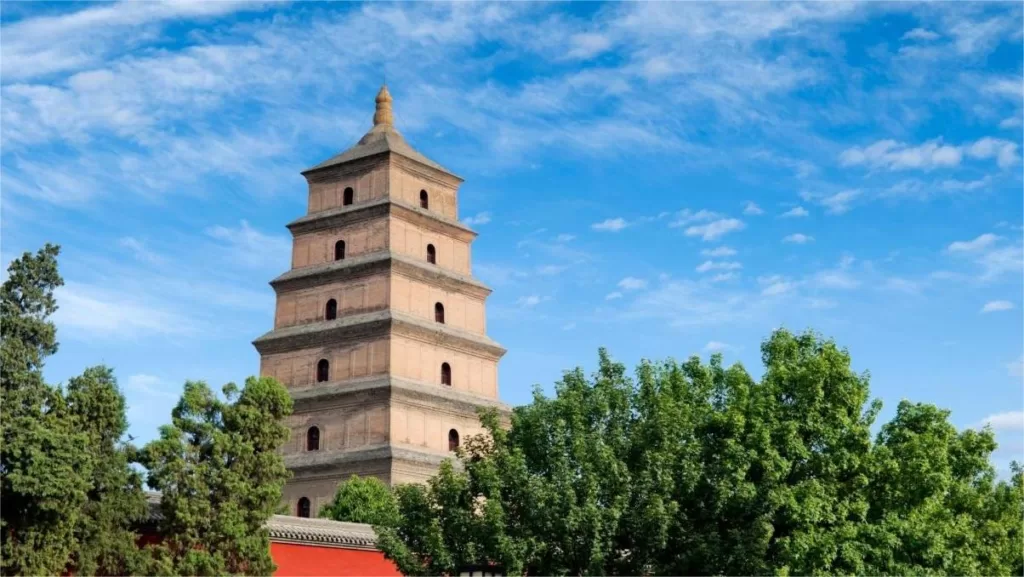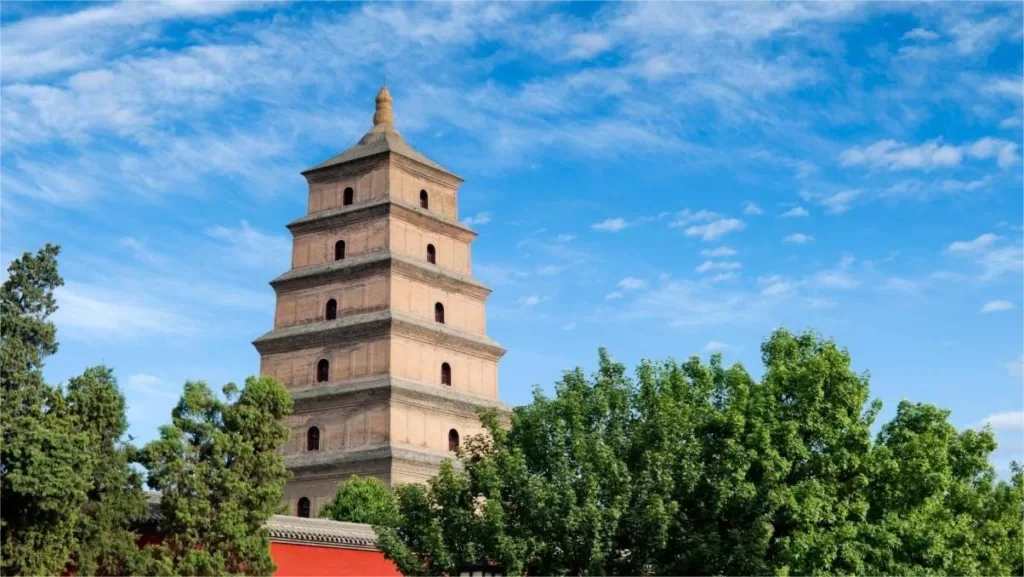Kleine Wildganspagode - Tickets, Öffnungszeiten, Highlights und TIps


The Small Wild Goose Pagoda (小雁塔, Xiaoyanta), situated in the Anren Fang of the Tang Dynasty’s Chang’an city (modern-day Xi’an, China), is also known as the “Jianfu Temple Pagoda.” It was constructed during the reign of Emperor Jinglong in the Tang Dynasty and stands as an important symbol that has endured through the centuries, alongside the famous Big Wild Goose Pagoda.
The Small Wild Goose Pagoda and the ancient bell housed in the nearby Jianfu Temple bell tower together form one of the “Eight Great Views of Guanzhong,” known as the “Morning Bell of the Wild Goose Pagoda.” This serene and historic site is an integral part of the Xi’an Museum.
The pagoda itself is a remarkable example of early Chinese square-shaped, multi-eave brick pagodas. Originally consisting of 15 stories, it currently stands at 13 stories tall, reaching a height of 43.4 meters. Its graceful architectural design reflects the artistic legacy of Buddhist construction during the Tang Dynasty, representing the integration of Buddhism into Han Chinese culture and leaving an indelible mark on the cultural heritage of the region.
Inhaltsübersicht
- Grundlegende Informationen
- Standort und Transport
- Highlights of Small Wild Goose Pagoda
- Vlog about Small Wild Goose Pagoda
- Nützliche Tipps aus Rezensionen zusammengefasst
- Facts about the Pagoda
Grundlegende Informationen
| Telefon Nummer | 0086-029-87568966; 0086-029-87803591 |
| Geschätzte Dauer der Tour | Etwa 1 Stunde |
| Ticketpreis | Free to enter the temple; 30 yuan to ascend the pagoda |
| Die Öffnungszeiten | 9.00 – 18.00; Last entry: 17.00 (15th March – 31st October) 9.00 – 17.30; Last entry: 16.30 (1st November – 14th March the next year) Closed on Tuesdays except for national holidays |
Standort und Transport
The Small Wild Goose Pagoda is situated in the Jianfu Temple complex, which is located in the southern part of the city, near the Xi’an Museum. The temple complex covers an area of about 15,000 square meters and includes several buildings and structures, including the pagoda itself, a bell tower, a drum tower, and several smaller shrines and pavilions. The specific address is 72 Youxi West Road, Beilin District, Xi’an.
Bus:
Take bus No. 21, 40, 46, 224, 521, or 700, get off at Xiaoyanta Stop (Small Wild Goose Pagoda), and walk about 100 meters to the west to reach the ticket office.
Take bus No. 21, 203, 258, or 700, get off at Nanshaomen Stop (Nanshao Gate), and walk about 150 meters to the east to reach the entrance.
U-Bahn:
Take subway line 2 or 5, get off at Nanshaomen Station (Nanshao Gate), get out from exit F, and walk about 300 meters to the west to reach the north gate
Highlights of Small Wild Goose Pagoda
Jianfu Temple

Jianfu Temple, originally named “Xianfu Temple,” was established in the year 684 AD. It was built as an offering of blessings by the royal family and relatives of Emperor Gaozong, following his passing. In 690 AD, its name was changed to “Jianfu Temple.” By 706 AD, the temple was expanded to include a translation and teaching center, essentially becoming another Buddhist scholarly institution after the renowned Great Ci’en Temple.
During the year 845 AD, Emperor Wuzong initiated a campaign against Buddhism, leading to the widespread suppression of Buddhist institutions. However, Jianfu Temple was among the few temples in Chang’an that were expressly permitted to continue their existence, highlighting its historical significance as one of the four preserved temples in the city during that tumultuous period.
Architektonischer Stil

The Small Wild Goose Pagoda is a fine example of ancient Chinese architectural style and is composed of several distinct parts, including the underground palace, the pedestal, the main tower, and the tower eaves.
The main tower of the Small Wild Goose Pagoda is square-shaped and constructed using green bricks. Originally, it had 15 stories and stood approximately 45 meters tall. However, during the devastating earthquake of 1556, the top two stories of the pagoda were destroyed, leaving it with 13 remaining stories. In 1989, the total height of the pagoda was measured at 43.395 meters.
The pedestal of the Small Wild Goose Pagoda is a square brick platform, and on the north and south sides of the base, there are exquisite Tang Dynasty stone carvings adorning the entryways.
The main tower of the pagoda is single-walled and hollow on the inside, with wooden floors and a wooden staircase spiraling up to the top of the pagoda, allowing visitors to ascend and enjoy the view from the tower’s summit.
Kulturelle Relikte

The Small Wild Goose Pagoda houses several significant cultural relics, each with its own historical and artistic importance:
- Tang Buddha’s Summit Victory Tantara Sutra Stele (唐佛顶尊胜陀罗尼经幢): Located in the “Hua Jing” courtyard at the southeast corner of the Small Wild Goose Pagoda, this stele was carved in the year 842. The stele is made of stone and has an octagonal column shape with a lotus bud-shaped top. At the base, there is a square pedestal with two niches on each side, featuring relief sculptures of musical performances. The front of the stele is inscribed with the “Buddha’s Summit Victory Tantara Sutra,” and it also includes the “Buddha’s Discourse on Rebirth in the Pure Lands of the Ten Directions.” This relic is a testament to the religious and artistic achievements of the Tang Dynasty.
- Headless Stone Buddha Statue (无头石刻佛像): The headless stone Buddha statue is one of the largest Tang Dynasty stone Buddha statues unearthed at the foot of the Small Wild Goose Pagoda. Despite its missing head and some damage, the statue is adorned in monastic robes and stands in an upright position on a lotus pedestal. It provides a glimpse into the artistic and religious practices of the Tang Dynasty.
- Iron Bell from the Jin Dynasty (金代铁钟): This iron bell, measuring 3.55 meters in height and weighing approximately 8000 kilograms, dates back to the Jin Dynasty. Each morning, the bell is rung at the temple, and its resonating sound can be heard for several miles around. This bell has both historical and acoustic significance, serving as a means of marking time and conveying spiritual messages to the community.
Lichtshow

The light show at the Small Wild Goose Pagoda is a mesmerizing display of colors, music, and history. The pagoda is illuminated at night with a stunning array of lights, creating a dazzling visual spectacle. The show tells the story of the Tang Dynasty and the pagoda’s role as a sacred Buddhist site. The colorful lights dance across the pagoda’s surface, highlighting intricate details of its architecture and carving, while accompanying music transports visitors back in time.
Vlog about Small Wild Goose Pagoda
Nützliche Tipps aus Rezensionen zusammengefasst
Ideal Time to Visit: The best time to visit Small Wild Goose Pagoda is in the late afternoon, around 3 to 4 PM. During this time, the sun hangs low in the sky, casting beautiful dappled light filtered through ancient trees onto the ground, creating a picturesque scene.
Capture Reflections: Look for the artificial lake on the far right side, where you can capture stunning reflections of the pagoda.
Unique Charm: Unlike the Big Wild Goose Pagoda, the Small Wild Goose Pagoda exudes a more rustic charm. It is relatively untouched, with minimal embellishments, showcasing its ancient architecture and the surrounding environment in a more authentic manner. Inside, you’ll find well-preserved ancient trees and small buildings, adding to the historical ambiance of the site.
Facts about the Pagoda

History of Small Wild Goose Pagoda

Differences between Giant and Small Wild Goose Pagoda

Bell in the Small Wild Goose Pagoda
Historische Stätte in Shaanxi, UNESCO-Welterbestätte